Key takeaways
- Digital fashion magazines enhance storytelling through interactivity, providing immersive experiences with videos and animations, while being eco-friendly and easily accessible.
- Effective fashion storytelling relies on emotional connections, authenticity, and strong visual elements, making garments resonate with deeper meanings and personal experiences.
- Erdem’s approach blends historical inspiration with personal narratives, elevating fashion from mere clothing to art, emphasizing the importance of authenticity and shared stories.
- Integrating personal experiences into fashion choices fosters deeper connections and enriches individual style, turning garments into vessels of personal history and emotion.
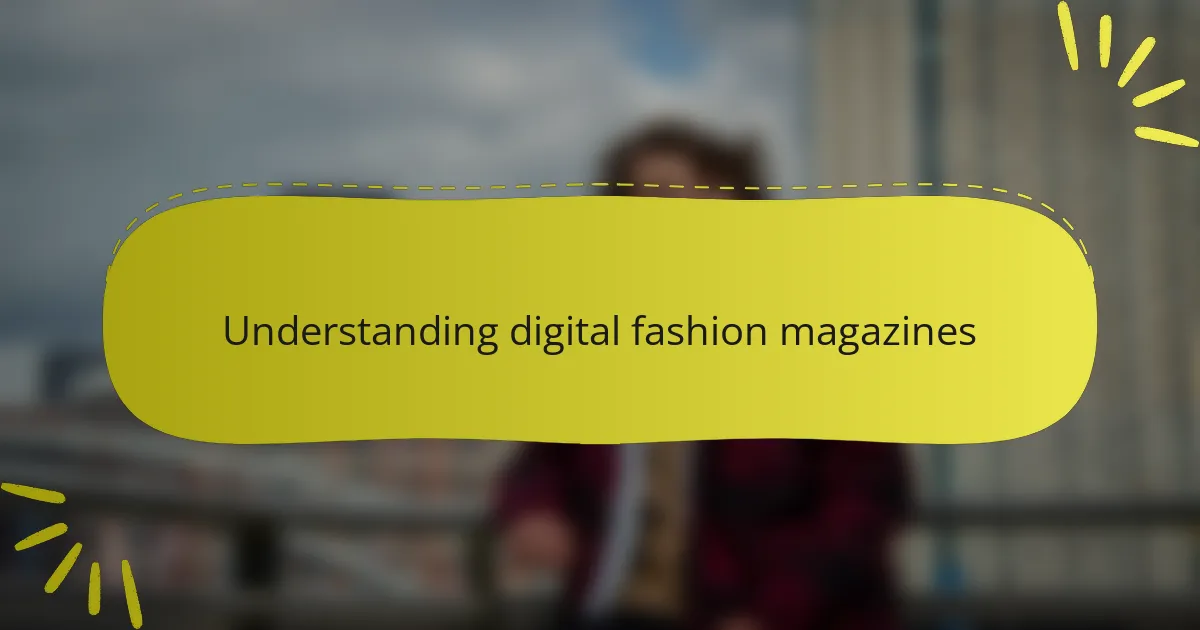
Understanding digital fashion magazines
Digital fashion magazines have transformed the way we consume fashion content. Unlike traditional print, they offer interactive features that enhance storytelling, allowing readers to engage deeply with the narratives behind the designs. I remember flipping through a well-curated digital magazine and being captivated not just by the styles, but by the stories interwoven with each collection.
These platforms not only showcase the latest trends but also provide a more immersive experience through videos, animations, and clickable links. This interactivity, I believe, really resonates with fashion enthusiasts, making the experience not just visual, but also emotional.
Now, let’s dive into some key comparisons of digital fashion magazines versus their print counterparts.
| Aspect | Digital Fashion Magazines |
|---|---|
| Accessibility | Available anytime, anywhere on various devices |
| Interactivity | Includes videos, links, and animations to enhance stories |
| Environmental Impact | More eco-friendly, reducing paper waste |
| Content Speed | Faster updates with real-time trend changes |
| Cost | Often lower production costs, sometimes free to access |
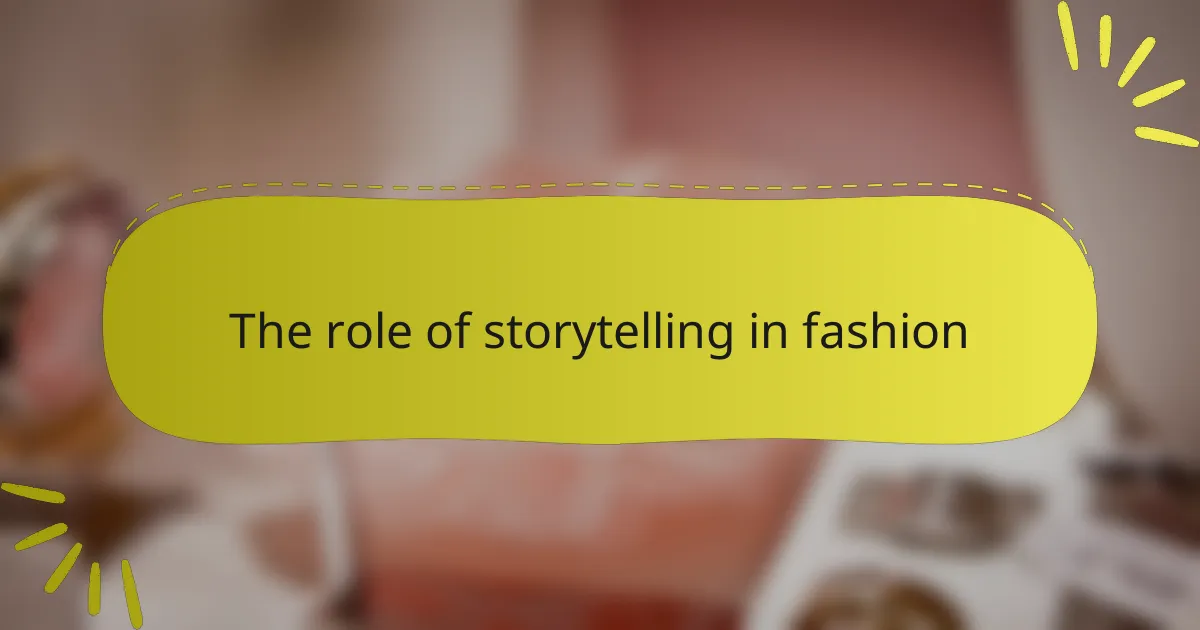
The role of storytelling in fashion
Storytelling in fashion transcends mere aesthetics; it creates a narrative that resonates with the audience. I’ve often found that the clothes we wear can evoke memories and emotions, almost like an unspoken language. For instance, I vividly remember a vintage dress I wore during a family gathering. The moment I slipped it on, I was transported back to my grandmother’s living room, where she used to tell stories of her youth—her tales infused the fabric with life.
- Fashion can express identity, allowing individuals to share their personal stories without saying a word.
- Influential designers, like Erdem, weave rich narratives through their collections, connecting the past with the present.
- Engaging storytelling in fashion helps build brand loyalty, as customers often form emotional attachments to the stories behind the clothes.
- Visual storytelling, through lookbooks and campaigns, allows consumers to imagine themselves within those narratives.
- The emotional resonance of a well-told fashion story can elevate simple garments into cherished memories or experiences.
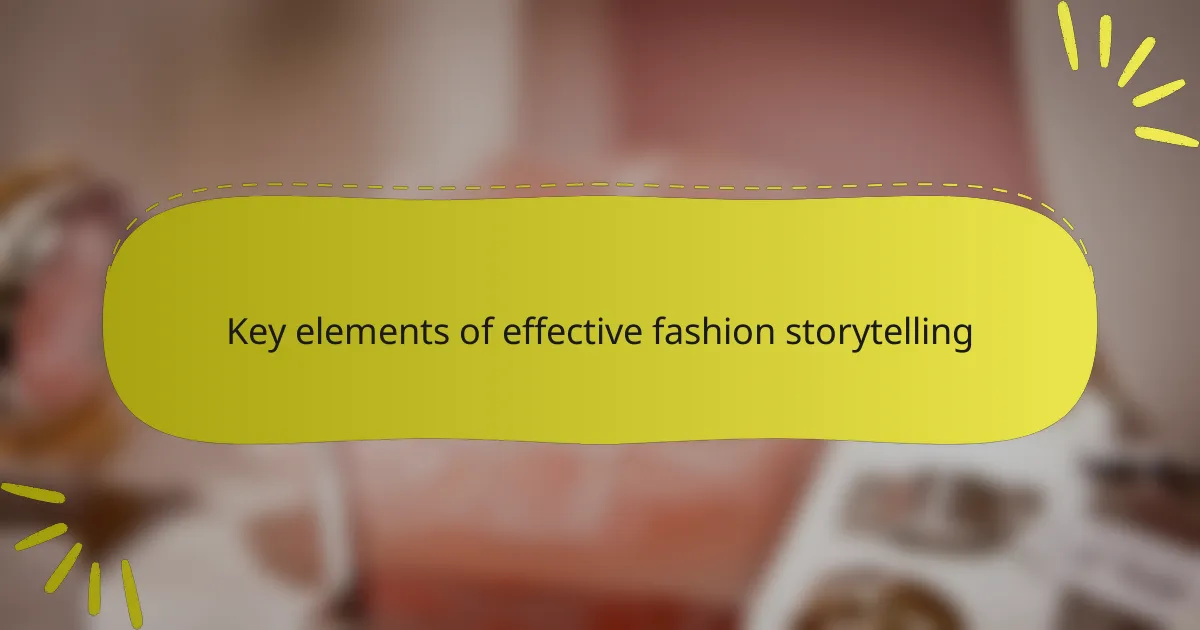
Key elements of effective fashion storytelling
Effective fashion storytelling hinges on several key elements that elevate the narrative beyond mere embellishments. One critical aspect is the emotional connection; I’ve seen firsthand how a designer captures their audience’s heart by sharing personal experiences or inspirations behind their collections. For example, when Erdem reflected on his childhood memories in the gardens of his family home, it resonated with me, making the garments feel alive with nostalgic charm.
Another important element is authenticity. Fashion storytelling should feel genuine and true to the brand’s ethos. I remember the first time I encountered a campaign that felt like an extension of the designer’s vision, not just a marketing ploy. It reminded me that when a story feels real, it invites the audience into a shared experience, fostering deeper connections with the fashion itself.
Finally, visual elements play a pivotal role in storytelling. Imagery in fashion can evoke emotions and create a powerful narrative. I often find myself captivated by lookbooks that blend artistry with clothing, transporting me into the world crafted by the designer. The imagery does more than showcase the pieces; it paints a vivid picture that resonates long after the fashion show ends. How does a simple outfit become a statement? By weaving together these elements, fashion storytelling transforms clothing into meaningful art.
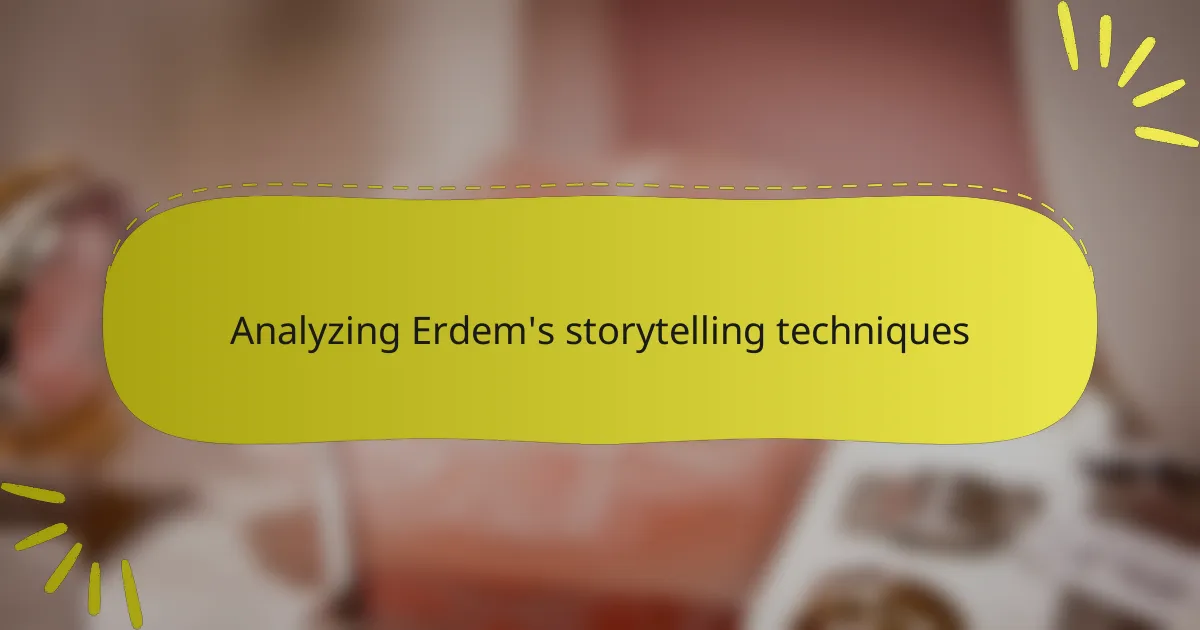
Analyzing Erdem’s storytelling techniques
Erdem’s storytelling techniques are deeply rooted in narrative essence, which often reflects a unique blend of history and personal experience. I remember the first dress I saw from his collection—its intricate florals felt like they were whispering tales of romance and nostalgia. Each piece is not just clothing; it becomes a canvas where emotions are stitched into the fabric, creating an intimate connection between the wearer and the story being told.
- Historical References: Erdem frequently draws inspiration from historical events and figures, weaving them seamlessly into modern narratives.
- Visual Storytelling: His collections are rich in visual elements that evoke certain moods, ranging from whimsical to somber, each aligning with the themes of the season.
- Emotional Resonance: There’s often a personal touch in his designs, as seen when he reflects on personal memories or family heritage, making his pieces feel like shared stories.
- Cultural Commentary: Through fashion, he engages in subtle dialogues about contemporary issues, inviting viewers to reflect on broader social narratives.
- Layered Meanings: Every garment comes with layers of meaning, inviting interpretation and creating a deeper appreciation for the craftsmanship behind it.
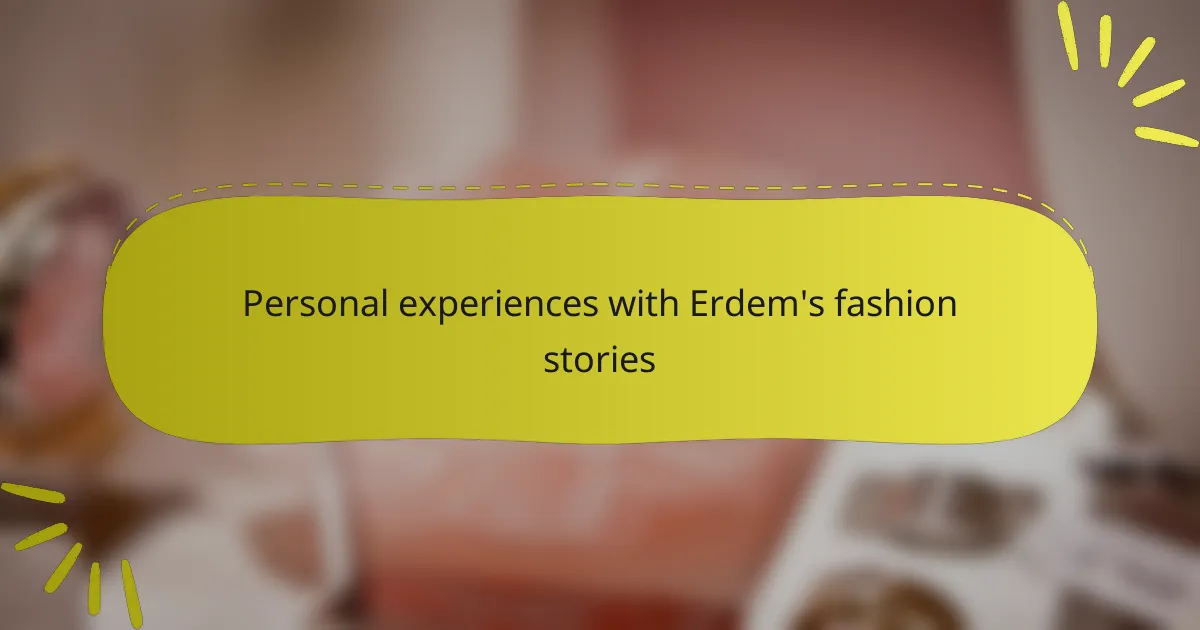
Personal experiences with Erdem’s fashion stories
Erdem’s fashion stories often resonate with me on a deeply personal level. When I first encountered his collections, I felt as if I was stepping into a beautifully crafted narrative. One stunning floral gown brought memories rushing back—a summer garden filled with laughter and sunlight from my childhood. It was not just a dress; it was an embodiment of joyful moments I had cherished, almost like Erdem had peeked into my memories and reflected them back through fabric.
There have been times when I’ve attended a fashion show featuring Erdem’s designs, and I could feel the atmosphere change as each piece walked down the runway. The way his garments flowed and transformed the models into living embodiments of a story transported me. I often wondered, how does a designer evoke such strong emotions through clothing? It’s the meticulous attention to detail and the deliberate choice of color and texture that create an experience rather than just a presentation.
I also recall browsing through a digital magazine that showcased one of Erdem’s seasonal collections. The accompanying narrative unveiled the inspiration drawn from historical references and personal memories. With each paragraph, I felt connected to the essence of his designs—a connection that made me realize the true power of storytelling in fashion. How incredible is it that a simple garment can carry such emotional weight and evoke a sense of belonging? It’s these experiences with Erdem’s works that reaffirm my belief in the magic that can be woven into fashion narratives.
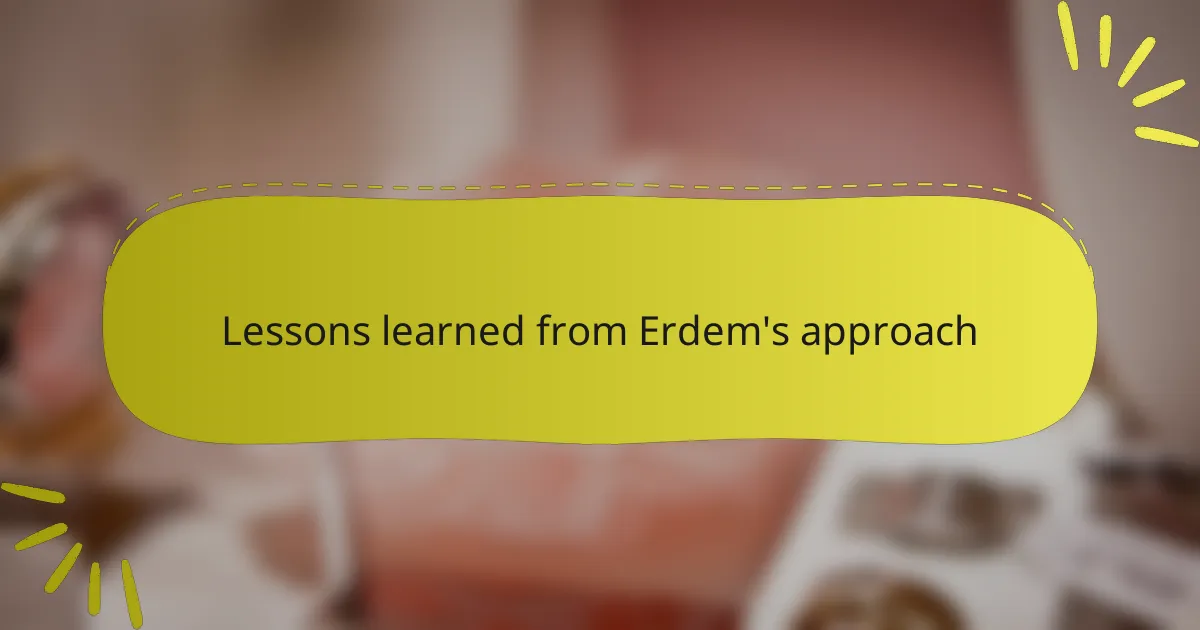
Lessons learned from Erdem’s approach
Erdem’s storytelling in fashion has taught me that weaving narratives into clothing can elevate a collection from mere garments to pieces of art. For instance, his ability to blend history and contemporary themes resonates deeply with me; it reminds me of how we all carry stories in our own styles. Each collection celebrates individuality, encouraging designers and wearers alike to express their unique journeys through fashion.
One lesson that stands out is the importance of authenticity. When I observe how Erdem incorporates personal experiences into his designs, it inspires me to reflect on my own experiences and how they influence my fashion choices. This approach makes clothes not just outfits, but vessels of personal history and emotion.
| Erdem’s Approach | What I Learned |
|---|---|
| Blending history with modern themes | Fashion is a storytelling medium |
| Authenticity in design | Embrace personal narratives |

Applying storytelling in your fashion journey
Applying storytelling in your fashion journey is about understanding the layers behind the clothes you wear. Often, I find that the garments I choose are reflections of who I am. I remember the excitement I felt when I discovered a vintage jacket that reminded me of my father’s style in the ’70s. Wearing it feels like carrying a piece of my family history, which adds a rich narrative to my personal style.
The act of sharing these stories can also deepen connections with others. I recall attending a fashion event where people openly discussed their favorite pieces and the memories tied to them. It sparked conversations that transformed casual acquaintances into friends. Does your wardrobe carry any stories? I encourage you to think about what your clothes represent and how they can express your journey to the world.
As I experiment with my fashion choices, I try to infuse my own experiences into the mix. I once paired a simple black dress with vintage accessories inherited from my grandmother. The combination told a story of past and present—a beautiful way to honor my roots while expressing my individuality. How might integrating your personal stories enhance your fashion journey? Embracing storytelling not only enriches your style but also allows others to connect with you on a deeper level.